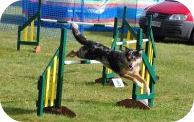Agility Shows
On a weekly basis there are thousands of people who compete in agility shows with their dogs across the country. Agility can certainly become very addictive!
Most agility shows offer two or three classes per dog. One of these is generally an "agility" class, which includes contact equipment (at least two items from the a-frame, dog walk and see-saw), and another will be a "jumping" class, including any equipment except for contact equipment. If you are able to enter a third class it is generally another agility or jumping class, or a special class such as steeplechase or pairs class.
Shows vary dramatically in terms of their size according to the part of the country they are held and the classes that they offer. Some shows may have as little as one or two rings, and others average 12 or 13 rings. The largest show in this country at the moment is the 3-day Kennel Club International Agility Festival which boasts an impressive 18 rings!!!
Graded and Combined Classes
Depending upon the size or nature of the show, classes will either be graded or combined.
Graded Classes
A graded class is a class where you are competing again other dogs of the same grade only, for example, "Grade 1 Jumping" or "Grade 7 Agility".
By the nature of graded classes they will be smaller than combined classes, but the competition may still be very tough!

Robbie won Grade 3 Jumping at Vyne Championship Agility show in Newbury in May 2007, the largest one-day agility show in the country! Go, Robbie!
Grade 3 tends to be the largest class when graded (mainly due to the discussion point raised on our Grading Structure page). Some of the larger shows in the country will easily have 300 large dogs competing in a Grade 3 class and may split the class into two parts as there are so many dogs entered of the same grade. It can be very tough beating that many dogs of a similar ability to your own dog!
Combined Classes
A combined class is one where you are competing against dogs of different grades, for example, Grade 1-3 Agility. The advantage of a combined class is that places at shows are generally awarded to 10 per cent of the class. In a class of 200 dogs rosettes will be awarded to 20th place meaning you have a higher chance of winning a rosette with your dog if you are clear.
The disadvantage of a combined class is if you are running a dog which is at the lower end of the grade classificiation (so a Grade 1 dog in a Combined 1-3 class) you generally have a lower chance of beating dogs in higher grades than you.

Lace came 2nd in Small G1-3 Agility at Chippenham Championship Agility Show in March 2009. She was Grade 1 at the time and just pipped to the post by an experienced handler with her Grade 3 dog. However, Lace went on to win three classes at her next show, zooming well and truly up to Grade 2!
Some shows with smaller entries opt to combine grades in their classes to increase the numbers in a class and to ensure it is not too easy for a dog to win out.